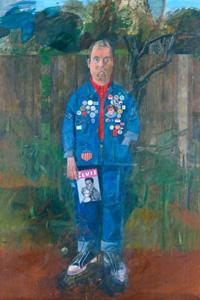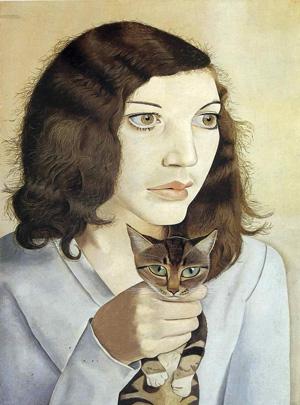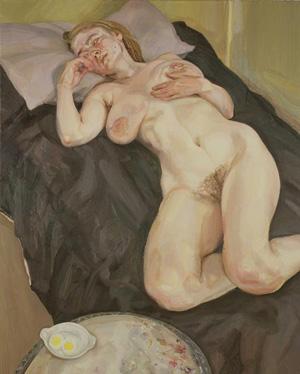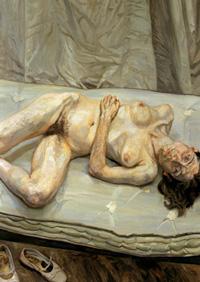Who would have guessed that the small and quirky magic realism paintings that Freud painted in his early career would presage the huge and almost violent nudes he went on to paint. This is one of the best Freud shows I’ve seen as it lulls you into a false sense of security with the gentle, lyrical and small early work so that you get hit with the full force of Freud’s personality in the later massive, paint encrusted flesh-dripping nudes.
It all starts quite mildly - take Man with a Feather (Self Portrait) 1942, this weirdly surreal painting has a gentle quirkiness that’s sort of entertaining - it actually reminds me of Peter Blake’s Self-Portrait with Badges.


Man With a Feather (Self Portrait) 1942 and Peter Blake's Self Portrait with Badges 1961
Some of these early paintings are even quite funny, like Girl with a Kitten, 1947, where the girl in question pretty much seems to be strangling a frankly bizarre cat that looks a quite a lot like an alien. But look closer at the eyes of the girl, those stunningly painted eyeballs are glistening like perfectly painted globes and are dazzling and disarming - there’s something in those eyes that hints at what is to come.

Girl with a Kitten, 1947
By 1967 Freud's beginning to hit his stride with fleshier paintings, although he’s still using some of the same imagery - comparing himself to a huge spiky plant in Reflection Listening (self portrait) 1967, in much the same way he did in the earlier painting Thistle (self portrait) 1946.


Reflection Listening (Self Portrait) 1967 and Thistle (Self Portrair) 1946
Then by 1972, he's started to produce some really classic paintings such as Naked Portrait 1972-73 - that full trade mark fleshiness is there and Freud’s visionary style of communicating the feel of a person through their utter nakedness is in full flow, it’s a journey into their souls and their sheer physicality.

Naked Portrait 1972-73
It’s an extraordinary thing to see - the paint becomes as physical as the flesh as it swirls around on the body - it’s actually like the paint becomes flesh, like some sort of art-magic is being connected to that makes a transmutation. And you can see all these brush marks so there’s also a weird contrast of paint and flesh.
Then when you look around the gallery the paintings are doing what any real art does, they’re changing the way you see things. You look at the faces of the other people attending the exhibition and you suddenly see them seem hyper real, as if a stronger light than normal is shining on them and the 3D qualities of their faces and skin are screaming out at you.
By 1980 with pics like Naked Portrait II, 1980-1, or Naked Girl with Egg 1980-1 the fleshy paint brush marks are thicker than before and the paint is chunkier and coagulated with dried on blobs. These paintings seem less sympathetic than the ones before - Freud’s eye has become so sharp that these paintings have become intensely visceral and almost aggressive as they fight to carve these 3D coloured humans.


Naked Portrait II, 1980-1 and Naked Girl with Egg, 1980-1
As the paintings then get bigger the show gets palpably opressive and impressive - the shift from those little surreal pics to the mammoth paint encrusted paintings of Leigh bowery is astonishing and the strength of personality of the artist is crushingly tangible.
In Lying by the Rags 1989-90, the paint is even more encrusted and less mimicking flesh but just jabbing right into it. The colours and the reds in the body are strong like blood. Close up the paintings have an almost abstract actuality, with the paint surface surprisingly close to that of Monet’s paintings.

Lying by the Rags, 1989-90
One of the fascinating pictures towards the end of the show is the portrait of David Hockney. He makes Hockney, who always seems to be smiling and laughing like a cheeky imp, into a thick set working man with a tough neck. He makes him look strong and intensely determined - and perhaps that’s what he’s really like.
Then something remarkable happens with the later paintings, Freud seems to discover some strange lyrical quality, like a late Shakespeare play. Take Naked Portrait Standing 1999-2000 - while all the thick paint work is still there, instead of communicating the feeling of a fight or aggression suddenly the paintwork seems to be communicating celebration. In a strange way the woman looks like a glowing angel, with the warmth of the yellows and the pinks shining through. The painting glows and it's like Freud has suddenly found some late and very personal colour sense. In a similar fashion in Naked Portrait 2001 again colour adds a sensitive softness. The painting is dominated by a cool blues, a really gorgeous blue that's light and cool but isn’t cold. (The colours are very noticeable in real life but don't come across so well in the reproductions below) For some reason there’s is an incredible positivity in these late pics.


Naked Portrair Standing, 1999-2000 and Naked Portrait 2001
This is a stunning exhibition - it’s remarkable also to look at it as a question about style and substance - as the style of his paintings becomes the way he can talk about the subject, the style and meaning have become intermingled. (It makes me think of the way Steve Jobs was criticised for an over-reliance on style, but maybe style is far more important than we might think.)
The other thing the exhibition leaves you with is awe of Freud’s determination to carry on doing what he did - at some points he was undoubtedly out of fashion but his will pushed his painting on until it could not be ignored any longer and became not so much fashionable but iconic. It’s an incredibly positive testament to what one can achieve.
Review by Robert Dunt, practising artist and Founder & CEO of ArtTop10.com - www.robertdunt.com
Lucian Freud Portraits runs at the National Portrait Gallery until 27 May 2012